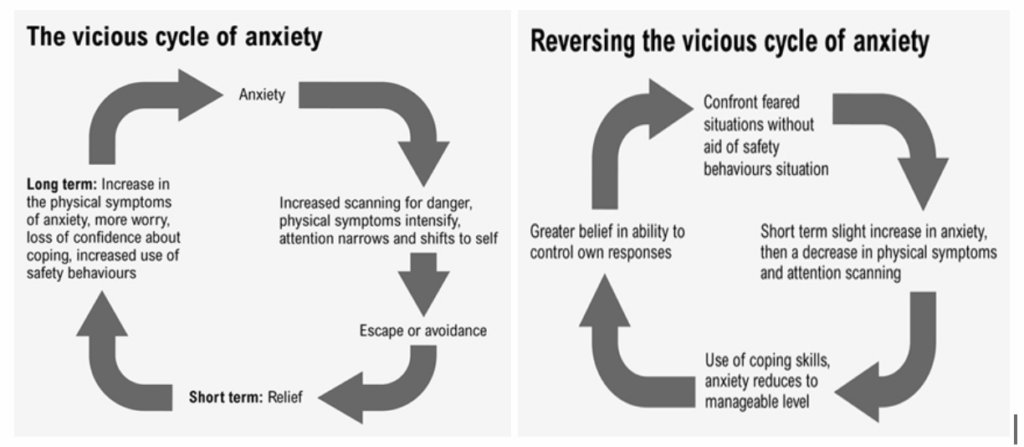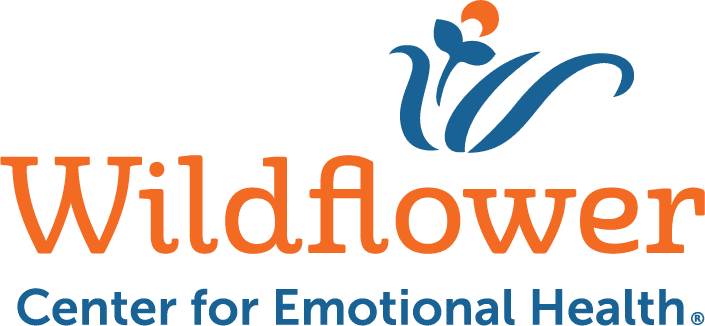
Have you ever experienced a fear so strong that you would do anything to avoid situations that bring that feeling on? Many people experience this in various forms like:
- Fear of heights and, in turn, avoiding tall buildings, elevators, and flying in airplanes
- Fear of spiders, bristling at the idea of weekend full of camping and hiking
- Fear of enclosed spaces (also commonly known as claustrophobia), meaning that corn mazes are simply out of the question
Most of the time, this fear and avoidance doesn’t get in the way of things that we care about, doing what matters in our life, and generally enjoying the time we have on this planet. Some may find, however, that it starts to take over, and grow and spread into areas we never imagined it to go. If you’ve experienced this, it’s also likely that you’ve tried many different things to “overcome,” “get rid of,” or “conquer” this fear and avoidance to no avail. Think of things like self-help books, meditation, talk therapy, TED talks, willing yourself to “just get over it,” acupuncture, the list goes on.
Does this sound familiar? If so, I want to reassure you that you are not alone, you are not broken, and there is hope. At Wildflower Center for Emotional Health, we utilize a treatment called Exposure and Response Prevention (ERP) to support clients who feel stuck in an endless cycle of anxiety, fear, and struggle in their lives.
What is ERP?
ERP is an evidence-based therapy practice which aims to support and teach people to confront their anxiety and distress vs. avoiding it at all costs (IOCDF, 2025). ERP is an effective psychotherapy modality utilized to treat various mental health conditions including anxiety, phobias, OCD, and eating disorders. But why confront anxiety and distress instead of avoiding it?
Consider this: if you’ve ever been unfortunate enough to come into physical contact with a poison ivy plant, you know that pretty soon you’ll develop blisters and sores that burn and itch incessantly. What is the very first thing your mind and body want to do when this happens? SCRATCH SCRATCH SCRATCH IT. And what happens when we scratch a poison ivy rash? Scratching it moves the plant oils around, and the rash starts to grow and spread to other areas of the body, making it much more painful and irritating than it was initially. Medical professionals typically advise that instead of scratching the rash, you leave it be and allow it to heal on its own (much easier said than done, of course).
We can think about anxiety and avoidance in a similar way. When we scratch the anxiety “itch” with avoidance, struggle, denial, etc., it grows and spreads into other areas of our life, and at times might impact our ability to connect with the things we care about. And while we might be able to successfully avoid coming into contact with a poison ivy plant, it’s much harder (and not possible) to avoid anxiety, distress, or discomfort in our day-to-day lives (Forsyth & Eifert, 2007).

(HealthyWA, 2025)
This Sounds…Uncomfortable
Similar to sitting with a poison ivy rash (and the urge to scratch the living daylights out of it), sitting with anxiety, distress, and anxious thoughts without scratching the anxiety “itch” with avoidance can be very uncomfortable. In fact, most folks feel some level of stress when they first hear about what ERP is all about. This is perfectly normal! Think of it this way:
Imagine you’ve set out on a hike toward a beautiful mountain in the distance — the view you’ve been dreaming of. But soon after you begin, you find yourself knee-deep in a swamp. The ground is soft and messy, your shoes are soaked, and every step feels harder than the last. You might think, “No one told me it would be this hard. Maybe I should forget it.”
In moments like this, you have a choice: stop and turn around where it’s uncomfortable, or keep going — through the mud, the “yuck”, one step at a time, to eventually make it to the destination.
Exposures can feel a lot like that. We don’t move toward painful or difficult emotions because we enjoy the discomfort — we do it because those experiences often stand between us and the life we want to build. By stepping into the “swamp,” we discover strength, healing, and the path forward that avoidance keeps us from finding.
The intention of ERP is not to overwhelm, flood, or otherwise expose you to an unmanageable amount of distress. The process of ERP is meant to be intentional, gradual, and at whatever pace you need.
If you’re struggling to find motivation to face your anxiety and distress head on, that is okay! Consider reflecting on your values and what matters most to you, deep down.
Values: The North Star of Exposures
We can think of values as the “north star” of ERP, the general direction in which we want to head in our lives. You can start to reflect on your values by completing a Values Exercise or alternatively, reflecting on and/or journaling about the following questions (adapted from “Clarifying Values”, worksheet from ACT Mindfully):
- Who do you look up to? Who inspires you? What personal strengths or qualities do they have that you admire?
- I wave this magic wand and you have total approval of everyone. No matter what you do, they love, respect, and admire you (whether you become a police officer or a serial killer). What would you then do with your life?
- What personal strengths or qualities do you already have? Which ones would you like to develop? How would you like to apply them?
- Imagine your 80th birthday party. Three people make speeches about you: what you stand for, what you mean to them. Imagine them saying whatever you most want to hear them say and mean about you.
- If you achieved “that” goal, then what would you do? How would your life be different as a result? How would you change? What would you do differently moving forward?
After clarifying some of your values, write or think about the following questions related to your values:
- What values did you choose and in your own words, what do they mean to you? Why do they matter to you?
- How do these values show up in your day-to-day life? Additionally, what is getting in the way of connecting with these values day-to-day?
- What would a values based life look like for you? What would be signs that you’re actively connecting with and prioritizing your values in your life?
- What would be some signs that tell you that you are disconnected from your values? What would tell you it may be time to reflect and re-engage with your values?
- What is the smallest, easiest step that you can take toward these values today? This week? This month?
Sitting with Discomfort – The Four “R”s
Another critical component of ERP is learning how to tolerate and sit with discomfort and anxiety as it rises and falls. The following Four “Rs” are adapted from Dr. Jeffry Schwartz’s Brain Lock (1996), and can be helpful anytime you’re noticing anxious or distressing thoughts or feelings:
- Re-label your thoughts as thoughts. Our minds give us all kinds of thoughts and urges in a day and we do not necessarily have to act on each one. Try relabeling the thoughts as thoughts, for example: “I’m noticing I’m having the thought that…” or “My brain is having the thought that…”
- Re-attribute the thoughts and urges as a byproduct of anxiety. Remember that treatment is going to be a process that takes time, energy, and dedication.
- Re-focus your energy and thoughts on alternative activities. Work around the thoughts by focusing your attention on something else when needed, at least for a few minutes. If possible, do another behavior or activity for a short time until the distress or anxiety reduces. You may not feel “calm” after this, but notice if your anxiety decreases in intensity.
- Re-value the thoughts and urges by reminding yourself of your values in life that you are working towards to create a valued based life. When you get overwhelmed by the thoughts, take a moment to reconnect with the value that you’ve established. Recall why you are doing this important work.
Final Thoughts
ERP is an evidence-based psychotherapy treatment that is gradual, intentional, and client centered, aiming to help people become “unstuck” in anxiety and avoidance and move toward situations and actions that bring meaning and purpose. An important piece to remember is that YOU are in charge of your exposure, should you choose to begin the process. Nobody is ever going to force you to do something that you are not willing to experience at that moment. To highlight the spirit and power behind exposure and response prevention, I leave you with this quote:
“The lotus is the most beautiful flower, whose petals open one by one. But it will only grow in the mud. In order to grow and gain wisdom, first you must have the mud — the obstacles of life and its suffering…. The mud speaks of the common ground that humans share, no matter what our stations in life. … Whether we have it all or we have nothing, we are all faced with the same obstacles: sadness, loss, illness, dying and death. If we are to strive as human beings to gain more wisdom, more kindness and more compassion, we must have the intention to grow as a lotus and open each petal one by one.” – Venerable Thupten Ngodrup

If you or someone you know is interested in learning more about Exposure and Response Prevention treatment at Wildflower, please reach out to our team by calling 312-809-0298 or completing our online inquiry form.
References
Act Mindfully: Workshops with Russ Harris (2010). A Quick Look at your Values. Retrieved from https://www.actmindfully.com.au/wp-content/uploads/2019/07/Values_Checklist_-_Russ_Harris.pdf
Act Mindfully: Workshops with Russ Harris (2025). Clarifying Values. Retrieved from: Retrieved from: https://www.actmindfully.com.au/upimages/Clarifying_Values_Summary.pdf
Forsyth, J., & Eifert, G. H. (2007). Mindfulness and acceptance workbook for anxiety: A guide to breaking free from anxiety, phobias, and worry using acceptance and commitment therapy. Oakland, CA: New Harbinger Publications.
HealthyWA (2025). Anxiety – reversing the vicious cycle. Government of Western Australia, Department of Health. Retrieved from: https://www.healthywa.wa.gov.au/articles/a_e/anxiety-reversing-the-vicious-cycle
International OCD Foundation (2025). Exposure and response prevention. Retrieved from: https://iocdf.org/about-ocd/treatment/erp/
Schwartz, J. (1996). Brain lock: free yourself from obsessive-compulsive behavior. New York, NY: HarperCollins Publishers.

